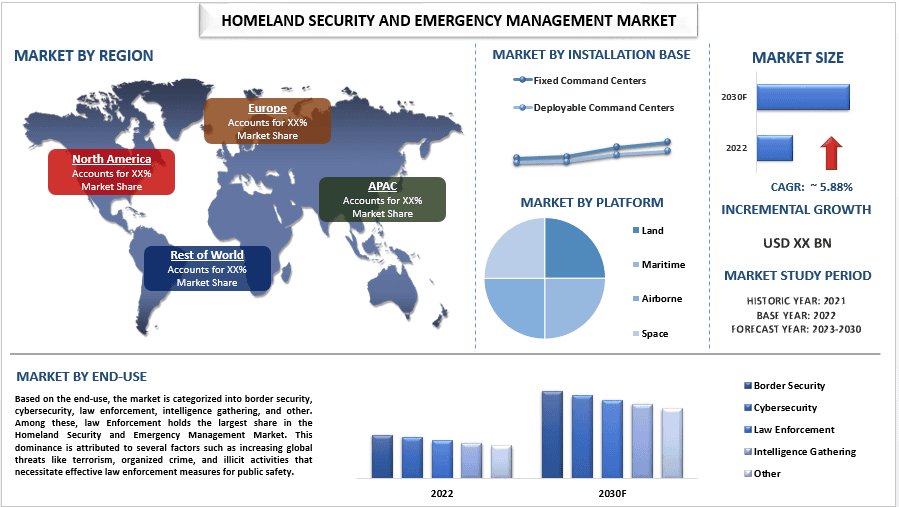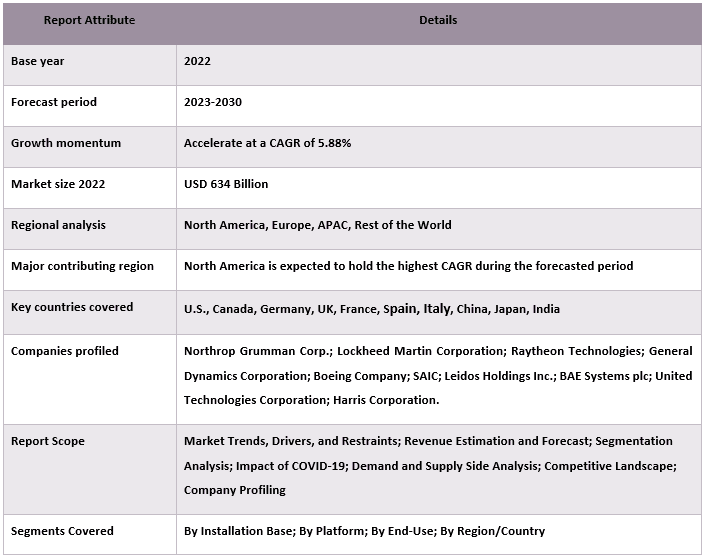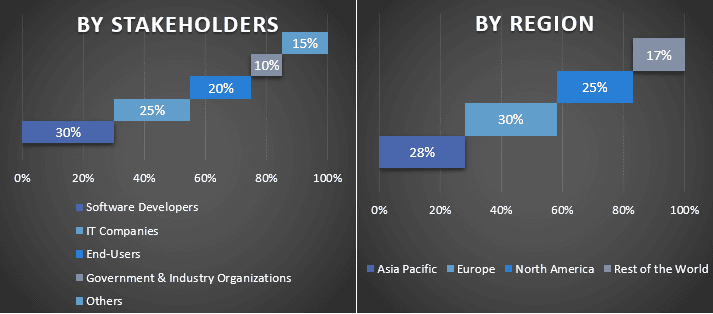- Home
- About Us
- Industry
- Services
- Reading
- Contact Us
Homeland Security and Emergency Management Market: Current Analysis and Forecast (2023-2030)
Emphasis On Installation Base (Fixed Command Centers, And Deployable Command Centers); Platform (Land, Maritime, Airborne, And Space); End-Use (Border Security, Cybersecurity, Law Enforcement, Intelligence Gathering, And Other) And Region/Country.

The Homeland Security and Emergency Management Market was valued at 634 billion in 2022 and is expected to grow at a steady rate of around 5.88% in the forecasted period (2023-2030) due to the increasing global security concerns, rising geopolitical tensions, advancements in technology, and the need for better infrastructure and resources to handle potential catastrophes. Homeland security and emergency management market refers to an industry that provides products, services, technologies, and solutions aimed at protecting the nation from various threats such as terrorism, natural disasters, cyber-attacks, and other crises. This includes prevention measures, preparedness efforts, response strategies, and recovery initiatives in case of any unforeseen events. Also, governments worldwide recognize the need for enhanced preparedness and responsiveness to potential crises. They are providing funding and support for research, development, and implementation of effective homeland security measures, fueling market expansion.
Some of the major players operating in the market include Northrop Grumman Corp.; Lockheed Martin Corporation; Raytheon Technologies; General Dynamics Corporation; Boeing Company; SAIC; Leidos Holdings Inc.; BAE Systems plc; United Technologies Corporation; Harris Corporation.
Insights Presented in the Report
“Among installation base, the deployable command centers segment leads the market during forecast period.”
Based on installation base, the market is bifurcated into fixed command centers, and deployable command centers. Among these, deployable command centers, have seen significant growth recently due to their capacity to react rapidly to emergencies across numerous locations. These types of setups give authorities the flexibility they need during crises by allowing them to coordinate activities from almost anywhere, making up around half of all installations currently being utilized throughout several end-user segments including military & defense forces, public safety organizations, transportation hubs, etc. fueling the market.
“Amongst platform, land segment is holding the major share during the forecast period.”
Based on the platform, the market is segmented into land, maritime, airborne, and space. Among these, the land-based segment of the Homeland Security and Emergency Management market has been growing significantly in recent years due to factors such as heightened concerns about border security and terrorism.
“North America to hold a significant share in the market.”
The North American region is leading the Homeland Security and Emergency Management Market. It is estimated to grow at the highest CAGR over the forecast period, with the United States being a key contributor to this growth. The region’s dominance is attributed to high spending on upgrading security solutions and systems, as well as significant investments in homeland security and public safety by the governments of the United States and Canada.
Homeland Security and Emergency Management Market Report Coverage

Reasons to buy this report:
- The study includes market sizing and forecasting analysis validated by authenticated key industry experts.
- The report presents a quick review of overall industry performance at one glance.
- The report covers an in-depth analysis of prominent industry peers with a primary focus on key business financials, product portfolio, expansion strategies, and recent developments.
- Detailed examination of drivers, restraints, key trends, and opportunities prevailing in the industry.
- The study comprehensively covers the market across different segments.
- Deep dive regional level analysis of the industry.
Customization Options:
The global Homeland Security and Emergency Management market can further be customized as per the requirement or any other market segment. Besides this, UMI understands that you may have your own business needs, hence feel free to contact us to get a report that completely suits your requirements.
Table of Content
Research Methodology for the
Homeland Security and Emergency Management Market Analysis (2023-2030)
Analyzing the historical market, estimating the current market, and forecasting the future market of the global Homeland Security and Emergency Management market were the three major steps undertaken to create and analyze the adoption of Homeland Security and Emergency Management market in major regions globally. Exhaustive secondary research was conducted to collect the historical market numbers and estimate the current market size. Secondly, to validate these insights, numerous findings and assumptions were taken into consideration. Moreover, exhaustive primary interviews were also conducted, with industry experts across the value chain of the global Homeland Security and Emergency Management market. Post assumption and validation of market numbers through primary interviews, we employed a top-down/bottom-up approach to forecasting the complete market size. Thereafter, market breakdown and data triangulation methods were adopted to estimate and analyze the market size of segments and sub-segments of the industry pertains to. Detailed methodology is explained below:
Analysis of Historical Market Size
Step 1: In-Depth Study of Secondary Sources:
Detail secondary study was conducted to obtain the historical market size of the Homeland Security and Emergency Management market through company internal sources such as annual reports & financial statements, performance presentations, press releases, etc., and external sources including journals, news & articles, government publications, competitor publications, sector reports, third-party database, and other credible publications.
Step 2: Market Segmentation:
After obtaining the historical market size of the Homeland Security and Emergency Management market, we conducted a detailed secondary analysis to gather historical market insights and share for different segments & sub-segments for major regions. Major segments are included in the report as installation base, platform, and end-use. Further country-level analyses were conducted to evaluate the overall adoption of testing models in that region.
Step 3: Factor Analysis:
After acquiring the historical market size of different segments and sub-segments, we conducted a detailed factor analysis to estimate the current market size of the Homeland Security and Emergency Management market. Further, we conducted factor analysis using dependent and independent variables such as various installation base, platform, and end-use Homeland Security and Emergency Management market. A thorough analysis was conducted of demand and supply-side scenarios considering top partnerships, mergers and acquisitions, business expansion, and product launches in the Homeland Security and Emergency Management market sector across the globe.
Current Market Size Estimate & Forecast
Current market sizing: Based on actionable insights from the above 3 steps, we arrived at the current market size, key players in the global Homeland Security and Emergency Management market, and market shares of the segments. All the required percentage shares split, and market breakdowns were determined using the above-mentioned secondary approach and were verified through primary interviews.
Estimation & Forecasting: For market estimation and forecast, weights were assigned to different factors including drivers & trends, restraints, and opportunities available for the stakeholders. After analyzing these factors, relevant forecasting techniques i.e., the top-down/bottom-up approach were applied to arrive at the market forecast for 2030 for different segments and sub-segments across the major markets globally. The research methodology adopted to estimate the market size encompasses:
- The industry’s market size, in terms of revenue (USD) and the adoption rate of the Homeland Security and Emergency Management market across the major markets domestically
- All percentage shares, splits, and breakdowns of market segments and sub-segments
- Key players in the global Homeland Security and Emergency Management market in terms of products offered. Also, the growth strategies adopted by these players to compete in the fast-growing market.
Market Size and Share Validation
Primary Research: In-depth interviews were conducted with the Key Opinion Leaders (KOLs) including Top Level Executives (CXO/VPs, Sales Head, Marketing Head, Operational Head, Regional Head, Country Head, etc.) across major regions. Primary research findings were then summarized, and statistical analysis was performed to prove the stated hypothesis. Inputs from primary research were consolidated with secondary findings, hence turning information into actionable insights.
Split of Primary Participants in Different Regions

Market Engineering
The data triangulation technique was employed to complete the overall market estimation and to arrive at precise statistical numbers for each segment and sub-segment of the global Homeland Security and Emergency Management market. Data was split into several segments & sub-segments post studying various parameters and trends in the areas of installation base, platform, and end-use in the global Homeland Security and Emergency Management market.
The main objective of the Global Homeland Security and Emergency Management Market Study
The current & future market trends of the global Homeland Security and Emergency Management market were pinpointed in the study. Investors can gain strategic insights to base their discretion for investments on the qualitative and quantitative analysis performed in the study. Current and future market trends determined the overall attractiveness of the market at a regional level, providing a platform for the industrial participant to exploit the untapped market to benefit from a first-mover advantage. Other quantitative goals of the studies include:
- Analyze the current and forecast market size of the Homeland Security and Emergency Management market in terms of value (USD). Also, analyze the current and forecast market size of different segments and sub-segments.
- Segments in the study include areas of installation base, platform, and end-use.
- Define and analysis of the regulatory framework for the Homeland Security and Emergency Management market industry.
- Analyze the value chain involved with the presence of various intermediaries, along with analyzing customer and competitor behaviors of the industry.
- Analyze the current and forecast market size of the Homeland Security and Emergency Management market for the major region.
- Major countries of regions studied in the report include Asia Pacific, Europe, North America, and the Rest of the World.
- Company profile of the Homeland Security and Emergency Management market and the growth strategies adopted by the market players to sustain in the fast-growing market.
- Deep dive regional level analysis of the industry
Frequently Asked Questions FAQs
Q1: What is the current market size and growth potential of the global Homeland Security and Emergency Management market?
Q2: What are the driving factors for the growth of the global Homeland Security and Emergency Management market?
Q3: Which segment has the largest share of the global Homeland Security and Emergency Management market by end-use?
Q4: Which region will dominate the global Homeland Security and Emergency Management Market?
Q5: Who are the key players operating in the global Homeland Security and Emergency Management Market?
Related Reports
Customers who bought this item also bought










